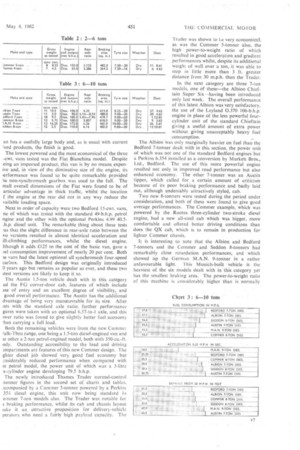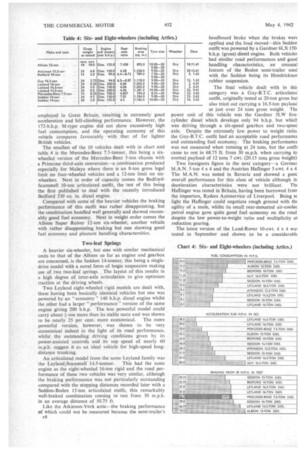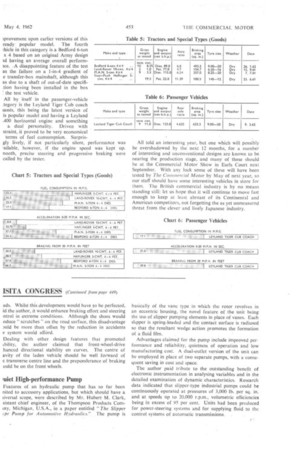Something for Everyone
Page 88

Page 89

Page 90

Page 91

If you've noticed an error in this article please click here to report it so we can fix it.
THE past 12 months have seen a fair amount of activitl among the road testing staff of The Commercia Motor. In all, 31 vehicles have been tested am reported upon since the last road-test summary was pub tidied in May, 1961. For a change, more heavy vehicle than any other one particular type were dealt with durim the period under review, including five articulated outfits Only one passenger vehicle was offered to us, whils Continental vehicles tested included an Italian Fiat 5-cwt van, two German M.A.N. models and a Mercedes-Ben Primrose conversion, and an Austrian Steyr-Puch Haflinge lightweight 4 x 4.
From this impressive collection it is difficult to pick ou any one outstanding vehicle. For novelty there was littl to beat the Haflinger, a most ingenious design with al impressive cross-country performance and a versatile load cum-passenger-carrying body. The heavy vehicles whicl showed the most signs of radical design improvement wer the Leyland Power-Plus models, of which two eight-wheele, rigids and one eight-wheeled articulated outfit were tested.
Taking the lightest vehicles first, these being dealt wit] in chart and table 1, a new name figures among the eigh vehicles falling into this category, this being the Triumpl 5-cwt. van, based on the Triumph Herald estate car. Bein so closely allied to a private-car design, the Triumph Courie combines smart appearance and good finish with livel performance and outstandingly good manceuvrability. Fut economy too was quite acceptable, while good engin accessibility and a minimum number of greasing point
make the Courier an easy van to service.
Nearest in size to the Courier was the Thames 5-cw model, derived from the current Anglia car. Again attrac tively styled, the latest Thames-of which there is a 7-cw version also-offers extremely good value for money. Th
an has a usefully large body and, as is usual with current 7.ord products, the finish is good.
The lowest powered and the most economical of the three -cwt.. vans tested was the Fiat Bianchina model. Despite eing an imported product, this van is by no means expenlye and, in view of the diminutive size of the engine, its performance was found to be quite remarkable provided he non-synchromesh gearbox was used to the full. The mall overall dimensions of the Fiat were found to be of articular advantage in thick traffic, whilst the location f the engine at the rear did not in any way reduce the vailable loading space.
Next in order of capacity were two Bedford 15-cwt. vans, ,ne of which was tested with the standard 49-b.h.p. petrol ngine and the other with the optional Perkins 4.99 40.5.h.p. diesel unit. The remarkable thing about these tests 'as that the slight difference in rear-axle ratio between the vo versions resulted in almost identical acceleration and ill-climbing performances, whilst the diesel engine, Ithough it adds £125 to the cost of the basic van, gave a lel consumption improvement of nearly 20 per cent. Both le vans had the latest optional all synchromesh four-speed earbox. This Bedford design was originally introduced 0 years ago but remains as popular as ever, and these two itest versions are likely to keep it so.
The Austin 1.5-ton vehicle dealt with in this category ad the FG corner-door cab, features of which include ase of entry and an excellent ,degree of visibility, and good overall performance. The Austin has the addinonal dvantage of being very manceuvrable for its size. After !sts with the standard axle ratio, further performance gures were taken with an optional 6.57-to-1 axle, and this )wer ratio was found to give slightly better fuel economy 'hen carrying a full load.
Both the remaining vehicles were from the new Commer talk-Thru range, one being a 1.5-ton diesel-engined van and le other a 2-ton petrol-engined mode), both with 350-cu.-ft ody. Outstanding accessibility to the load and driving mnpartments are features of this new Commer design. The ghter diesel job showed very good fuel economy but )nsiderably reduced performance when compared with ie petrol model, the power unit of which was a 3-litre x-cylinder engine developing 79.5 b.h.p.
The newly introduced Thames Trader normal-control -Loaner figures in the second set of charts and tables, :.companied by a Commer 5-tonner powered by a Perkins 354 diesel engine, this unit now being standard in ommer 7-ten models also. The Trader was notable for s braking performance, whilst its cab and chassis layout lake it an attractiVe proposition for delivery-vehicle perators who need a fairly high payload capacity. The
Trader was shown to be very economical, as was the Commer 5-tonner also, the high power-to-weight ratio of which resulted in good acceleration and gradient performances whilst, despite its additional weight of well over a ton, it was able to stop in little more than 3 ft. greater distance from 30 m.p.h. than the Trader.
In the next category are three 7-ton models, one of these-the Albion Chieftain Super Six-having been introduced only last week. The overall performance of this latest Albion was very satisfactory, the use of the Leyland 0.370 106-b.h.p. engine in place of the less powerful fourcylinder unit of the standard Chieftain giving a useful amount of extra power without giving unacceptably heavy fuel consumption.
The Albion Was only marginally heavier on 'fuel than the Bedford 7-tonner dealt with in this section, the power unit of which was not one of the standard Bedford.engines but a Perkins 6.354 installed as a conversion by Murkett Bros., Ltd., Bedford. The use of this more powerful engine resulted not only in improved road performance but also enhanced economy. The other 7-tonner was an Austin tipper, which called for a certain amount of criticism because of its poor braking performance and badly laid out, although undeniably attractively styled, cab.
Two new 8-tonners were tested during the period under consideration, and both of these were found to give good average performances. The Commer example, which was powered by the Rootes three-cylinder two-stroke diesel engine, had a new all-steel cab which was bigger, more comfortable and offered better driving conditions than does the QX cab, which is to remain in production for lighter Commer chassis.
It is interesting to note that the Albion and Bedford 7-tonners and the Commer and Seddon 8-tonners had remarkably close retardation performances; and which showed up the German M.A.N. 9-tormer in a rather unfavourable light. This Munich-built vehicle is the heaviest of the six models dealt with in this category yet has the smallest braking area. The power-to-weight ratio of this machine is considerably higher than is normally
employed in Great Britain, resulting in extremely good acceleration and hill-climbing performance. However, the 172-b.h.p. M-type engine did not show excessively high fuel consumption, and the operating economy of this• vehicle compares favourably with that of far lighter British vehicles.
The smallest of the 10 vehicles dealt with in chart and table 4 is the Mercedes-Benz 7.5-tonner, this being a sixwheeled version of the Mercedes-Benz 5-ton chassis with a Primrose third-axle conversion-a combination produced especially for Malaya where there is an 8-ton gross legal limit on four-wheeled vehicles and a 12-ton limit on sixwheelers. Next in order of capacity comes the BedfordScammell 10-ton articulated outfit, the test of this being the first published to deal with the recently introduced Bedford 330 cu. in. diesel engine.
Compared with some of the heavier vehicles the braking performance of this outfit was rather disappointing, but the combination handled well generally and showed reasonably good fuel economy. Next in weight order comes the Albion Super Reiver 12-ton six-wheeler, another vehicle with rather disappointing braking but one showing good fuel economy and pleasant handling charactersitics.
Two-leaf Springs
A heavier six-wheeler, but one with similar mechanical units to that of the Albion so far as engine and gearbox are concerned, is the Seddon 14-tonner, this being a singledrive model with a novel form of bogie suspension making use of. two two-leaf springs., The layout of this results in a high degree of inter-axle articulation to give optimum traction at the driving wheels.
Two Leyland eight-wheeled rigid models are dealt with, these having been basically identical vehicles but one was powered by an economy 140 b.h.p. diesel engine whilst the other had a larger " performance " version of the same engine giving 200 b.h.p. The less powerful model could carry about +-ton more than its stable mate and was shown to be nearly 25 per cent. more economical. The more powerful version, however, was shown to be very economical indeed in the light of its road performance, whilst the outstanding driving conditions given by its power-assisted controls and its top speed of nearly 60 m.p.h. suggest it as an ideal vehicle for high-speed longdistance trunking.
An articulated model from the same Leyland family was
the Leyland:Scammell 14.5-tonner. This had the same engine as the eight-wheeled 16-ton rigid and the road performance of these two vehicles was very similar, although the braking performance was not particularly outstanding compared with the stopping distances recorded later with a Seddon-Boden 15-ton articulated outfit, this remarkably well-braked combination coming to rest from 30 m.p.h. in an average distance of 50.75 ft.
Like the Atkinson-York artic-the braking performance of which could not be measured because the semi-trailer's headboard broke when the brakes were applied and the load moved-this Seddor outfit was powered by a Gardner 6LX 150. b.h.p. (gross) diesel engine. Both vehicles had similar road performances and good handling characteristics, an unusual feature of the Boden semi-trailer used with, the Seddon being its Hendrickson rubber suspension.
Dry 2. 6.61 Dry 22. 951 Wet 23. 3.62 Dry 23. 252 Dry 16. 3.62
The final vehicle dealt with in this category was a Guy-B.T.C. articulated outfit, originally tested at 20-ton gross bui also tried out carrying a 16.5-ton payload at just over 24 tons gross weight. The power unit of this vehicle was the Gardner 5LW five cylinder diesel which develops only 94 b.h.p. but which was driving through a six-speed gearbox and two-speed axle. Despite the extremely low power to weight ratio the Guy-B.T.C. outfit had an acceptable road performance and outstanding fuel economy. The braking performance was not measured when running at 24 tons, but the outfit came to rest in 68.75 ft. from 30 m.p.h. when carrying its normal payload of 12 tons 7 cwt. (20.15 tons gross weight) Two foreigners figure in the next category-a Germar MAN. 5-ton 4 x 4 and the Austrian Haflinger 5-cwt. 4 x 4 The M.A.N. was tested in Bavaria and showed a gooc overall performance for this class of vehicle although it deceleration characteristics were not brilliant. The Haflinger was tested in Britain, having been borrowed frorr the importers, Ryders Autoservice of Liverpool. Being se light the Hollinger could negotiate rough ground with the agility of a mule, whilst its small rear-mounted air-cooiec petrol engine gave quite good fuel economy on the road despite the low power-to-weight ratio and multiplicity ol reduction gearing.
The latest version of the Land-Rover 10-cwt. 4 x 4 wa! tested in September and shown to be a considerable Iprovexnent upon earlier versions of this ready popular model. The fourth :hick in this category is a Bedford 6-ton x 4 based on an original Army design id having an average overall performice. A disappointing feature of the test as the failure on a 1-in-4 gradient of e transfer-box mainshaft, although this as due to a shaft of out-of-date specifition having been installed in the box the test vehicle.
All by itself in the passenger-vehicle .tegory is the Leyland Tiger Cub coach tassis, this being the latest version of is popular model and having a Leyland .400 horizontal engine and something a dual personality. Driven with straint, it proved to be very economical
terms of fuel consumption. Surprisgly lively, if not particularly silent, performance was ,ailable, however, if the engine speed was kept up. nooth, precise steering and progressive braking were called by the tester.
All told an interesting year, but one which will possibly be overshadowed by the next 12 months, for a number of interesting and unconventional designs are known to be nearing the production stage, and many of these should be at the Commercial Motor Show in Earls Court next September. With any luck some of these will have been tested by The Commercial Motor by May of next year, so our staff should have some interesting vehicles in store for them. The British commercial industry is by no means standing still: let us hope that it will continue to move fast enough to keep at least abreast of its Continental and American competitors, not forgetting the as yet unmeasured threat from the clever and lively Japanese industry.


































































































































































































































































